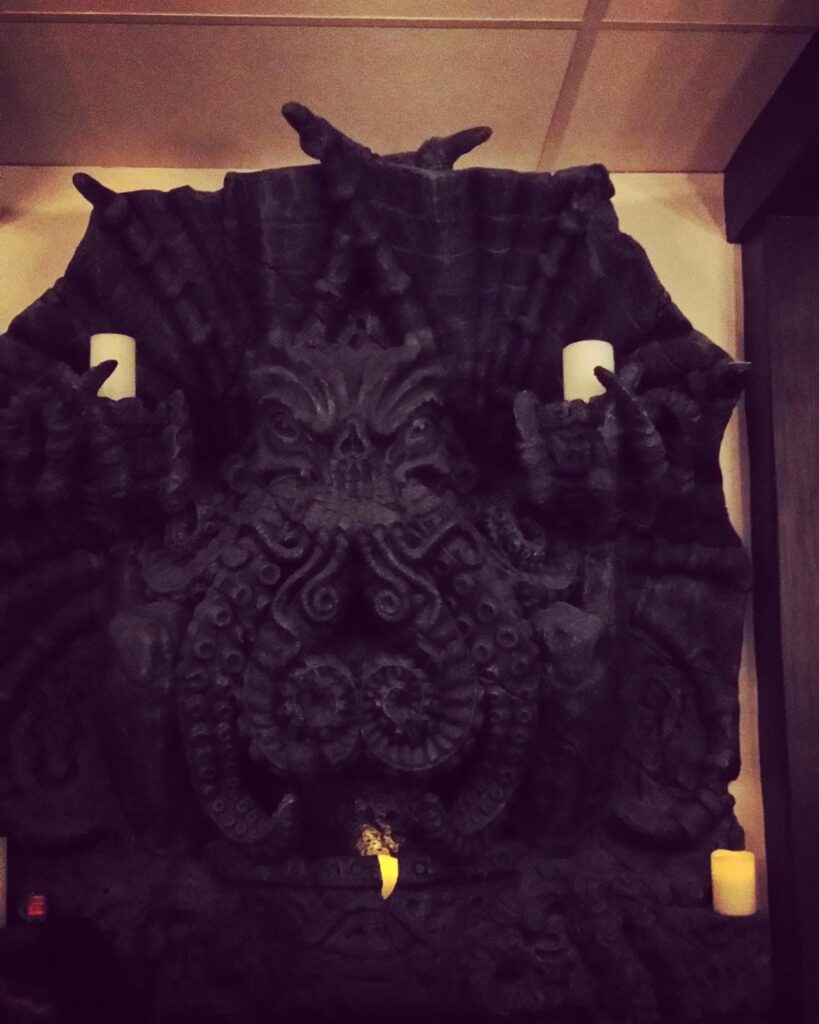MANJARI MISRA
ONCE KRAKEN, NOW TENTA-KOOL! ANTHROZOOLOGY OF OCTOPUSES
Manjari Misra
Once Kraken, now Tenta-kool! Anthrozoology of Octopuses
W
hat are octopuses?
Scientifically speaking, they are members of the order Octopoda, part of the class Cephalopoda, under Phylum Mollusca. These are bodied creatures that are bilaterally symmetric, have two eyes, eight tentacles with two rows of suckers, and a beak in the middle of their eight arms (Wells, 1978).
However, when one asks a novice about an octopus, a common theme surrounding it is ‘alien on earth’ (Wells, 1978; Mather et al. 2010; Courage, 2013). The fascination with these creatures dates back millennia, evidenced in old scriptures and tales. Stories of awe-inspiring gods and malevolent beasts have permeated into the modern age, transfigured into curiosity and fascination. These perceptions have led to its status as one of the icons of the ocean and a means for conservationists to engage with the public on topics regarding the protection of our marine ecosystem. The following are examples of some of the historical and modern facets of the octopus.
Monster
One would rather get this facet out of the way first, to rip the bandage so to speak.
The octopus’s reputation as a monstrous creature from the unknown ocean depths is classic, and perhaps the most common imagery it conjures. One of the most popular iterations of this facet is, of course, the Kraken.
Scandinavian folklore describes this creature as a massive cephalopod terrorizing sailors off the coast of Norway and Greenland (Lee, 1883). The legend of the Kraken has been reimagined several times since ancient times. One of the first literary records of this creature dates back to an 1180 manuscript by King Sverre of Norway, who describes it as a massive beast capable of sinking ships (Salvador and Tomotani, 2014).
Works like that of Lord Alfred Lord Tennyson’s “The Kraken” and Jules Verne’s Twenty Thousand Leagues Under the Sea highlight the monster’s lingering popularity in the nineteenth century. Then of course, in the twenty century, we were introduced to one of the Great Old Ones within the Lovecraftian pantheon: Cthulhu. This malevolent cosmic deity first appears in H. P. Lovecraft’s short story, “The Call of Cthulhu,” in 1928. He describes it as a kind of chimaera with the features of an octopus, dragon, and human. Even in the twenty-first century, the Kraken is still depicted in popular culture like in Disney’s Pirates of the Caribbean: Dead Man’s Chest, where the monster follows the bidding of the infamous pirate Davy Jones.
The horrifying depictions of octopuses are not limited to the Western world. According to Ainu and Shinto folklore from Japan, there is an enormous part-human-part-octopus creature called Akkorokamui, living in Funka Bay, in Hokkaidō (Batchelor, 1901; Srinivasan, 2017).
In a time of superstition and navigational uncertainty, ancient people struggled to comprehend the naval mishaps that frequently befell them. Blaming their misfortunes on demons and monsters, beneath the waves, was a way for them to cope and made for great stories. Even the most benign of encounters with strange and/or unknown creatures were embellished to fit a more fantastical narrative (Ashton, 1890; Salvador and Tomotani, 2014). In the case of the octopus, these narratives were not limited to just horror and tragedy.
Deity
Octopuses have not just been feared but also revered. Many cultures, from the Pacific Northwest and Polynesian Islands to South America, have worshiped octopuses as spiritual guides and deities. In fact, even the Akkorokamui, is worshiped in Shinto temples in Japan (Murakami and Mizuki, 2015; Srinivasan, 2017).
In the Gilbert Islands, in the Pacific Ocean, there is the octopus-god Na Kika. Locals believe that he pushed up the Earth from the bottom of the ocean using many arms, creating the islands we have today (Courage, 2013). Then we have Kanaloa, one of four major deities in ancient Hawai’i mythology. What one gathers from oral traditions and the few written records is that Kanaloa is associated with sunsets, the ocean currents and wind, the Southern Hemisphere, and is a teacher of the arcane arts.
According to Tahitian lore, the supreme god of creation Taʻaroa, brings forth the foundation of the earth and heavens, which turns into an octopus and then the ocean. All other octopuses are considered to be shadow forms of this foundational being. They also link the octopus to compasses and navigation as its eight arms are associated with the navigation directions on a typical compass (Au, 2018).
Like the ocean, these deities are considered neither benevolent nor malicious, they simply do as they please. Their deeds have only recently been put to ink in academia and begun to inspire a new generation of humans.
Muse
Here is where things get more interesting and creative.
Thanks to their rather unique and other-worldly physiology, octopuses have inspired artists and scientists from all over the globe. Their body plan and behavior are either aspirational or to be feared, as discussed previously.
Beyond the villainous characters and organizations of Disney and alien movies, octopuses have been shown in a more gentle light. From their fun reimagined counterpart in Pokémon to the gentle everyday children’s cartoon, Oswald, it goes to show that octopuses cannot be kept in a box! One, of course, has to commend the human mind for its ability to produce an eclectic range of literature and art just from the octopus.
However, with the advent of scientific advancements in the field of zoology, there is now more research on the octopus’s behavior and mechanics that are now gaining more traction amongst the scientific community. For example, the very arms of the octopus that have been instrumental in inspiring the tales, have inspired great advancements in robotics.
One study remarks on how the octopus’s arms have the ability to bend in all possible directions and can elongate and stiffen at rapid rates. These features fascinate the scientists and drive them to design an artificial muscular hydrostat structure with the hopes to use it to develop a prototype arm (Laschi et al. 2009). In another study, scientists developed a functioning eight-armed soft robot and put it through a series of trials to test its dexterity and locomotion. The robot walked on land as well as underwater in a manner similar to that of an actual octopus and could even grasp various kinds of objects (Cianchetti et al. 2015)!
Icon
In recent years, octopuses have worked their way into stardom. Scientific documentaries like Octopus: Making Contact on PBS and Blue Planet II on BBC have caught the attention of the average watcher. The Octopus in My House on BBC was especially gripping, chronicling the relationship of a professor and the octopus he lives with and studies.
There are even books specifically about these creatures like The Soul of an Octopus by Sy Montgomery, where the author brilliantly describes her interactions with different octopuses and how enthralled she is by each one (Montgomery, 2015).
They have become icons for several aquariums. Be it the New Zealand Aquarium or the Seattle Aquarium, many guests make the journey to visit them and learn more about these bizarre escape artists. The Sea Life Oberhuasen in Germany even promoted their Common Octopus in a unique way. In 2010 their then octopus Paul, was lauded for his divination abilities during the FIFA World Cup (Mather et al. 2010; Ronay, 2010; Courage, 2013).
The Scuba diving community is also enthralled by octopuses, describing their encounters with it as the highlight of their lives and thus, are rather protective of them (Mather et al. 2010; Godfrey-Smith, 2016).
Food
Last but not least, many humans love consuming octopuses. While an acquired taste for some, they are extremely popular in East Asian countries like China and Japan, the Pacific Islands, and Europe. Whether it be in the Japanese Takoyaki, Malta pizza or in Spanish grills, octopuses have found a specific place in the human palate, either as a delicacy or staple, depending on the region.
Despite the octopus being a common traditional meal in many cultures, its harvest is not favorably looked at, especially in the United States. This was exhibited when a diver at Alki Point in Seattle, caught and killed an octopus for food. While he had the necessary permits to do so, the public, especially the Seattle diving community, was not pleased as this hunt involved the diver beating the octopus to death in the water. This incident resulted in a restriction on octopus hunting in popular dive sites (Associated Press, 2013).
Summary
Humans have always considered octopuses to be other-worldly. Their ancient depictions of monsters and gods definitely highlight this belief. Even in the modern age, where the octopus is better understood and even studied for its various attributes, people still akin it to monsters at both a local and cosmic level. Some depictions that are more kid-friendly and benign, as well as the real-life versions, are garnering more attention every day as aliens on earth. Then there is, of course, the more graphic content surrounding the octopus as well as its centuries-long reputation as a delectable food item. One way or another, humans have always and will continue to be fascinated by these animals and will be drawn to octopus related media and programs.

The Great Old One Cthulhu, High Priest of the Great Old Ones, The Great Dreamer and, The Sleeper of R'lyeh.
Sources
Ashton, J., 1890. Curious Creatures in Zoology: Illustrated Legends and Myths from Around the World. Courier Dover Publications, pp.159-161.
Associated Press, 2013. Washington Panel Restricts Octopus Hunting. [online] KOMO.
Au, J., 2018. He Hulikoʻa Kanaloa-Seeking the Depths of Kanaloa (Doctoral dissertation, University of Hawaiʻi at Mānoa).
Batchelor, J., 1901. The Ainu And Their Folk-Lore. London: Religious Tract Society, pp.519-586.
Cianchetti, M., Calisti, M., Margheri, L., Kuba, M. and Laschi, C., 2015. Bioinspired locomotion and grasping in water: the soft eight-arm OCTOPUS robot. Bioinspiration & biomimetics, 10(3), p.035003.
Courage, K.H., 2013. Octopus!: The Most Mysterious Creature in the Sea. New York: Current.
Deviantart, 2020. Cthulhu. [image] Available at: <https://www.deviantart.com/disse86/art/Cthulhu-594128034> [Accessed 1 June 2020].
Godfrey-Smith, P., 2016. Other minds: The octopus and the evolution of intelligent life. London: William Collins.
Laschi, C., Mazzolai, B., Mattoli, V., Cianchetti, M. and Dario, P., 2009. Design of a biomimetic robotic octopus arm. Bioinspiration & biomimetics, 4(1), p.015006.
Lee, H., 1883. Sea Monsters Unmasked. London: William Clowes & Sons, pp.2-72.
Lovecraft, H.P., 2014. The complete fiction of HP Lovecraft. New York: Race Point Publishing, pp 363-387.
Mather, J.A., Anderson, R.C. and Wood, J.B., 2010. Octopus: the ocean’s intelligent invertebrate. London: Timber Press.
Montgomery, S., 2015. The Soul of an Octopus: A surprising exploration into the wonder of consciousness. New York: Simon and Schuster.
Murakami, K. and Mizuki, S., 2015. Nihon Yokai Daijiten (Japan’s Spectre Encyclopedia). Tokyo: Kadokawa Shoten, pp.204-205.
Pokémon, n.d. Octillery. [image] Available at: <https://www.pokemon.com/us/pokedex/octillery> [Accessed 1 June 2020].
Ronay, B., 2010. Did Paul The Octopus Predict His Own Death?. [online] The Guardian.
Salvador, R.B. and Tomotani, B.M., 2014. The Kraken: when myth encounters science. História, Ciências, Saúde-Manguinhos, 21(3), pp.971-994.
Srinivasan, A., 2017. The Sucker, the Sucker!. London Review of Books, 39(17), pp.23-25.
Wells, M.J., 1978. Octopus: physiology and behaviour of an advanced invertebrate. London: Chapman and Hall Ltd.
Wood, J.B. and Anderson, R.C., 2004. Interspecific evaluation of octopus escape behavior. Journal of Applied Animal Welfare Science, 7(2), pp.95-106.

Manjari Misra
curator
Manjari is a marine conservationist and enjoys engaging with various stakeholders about marine wildlife and ecosystems. She has a multi-disciplinary background: intern at the Wildlife Institute of India, research assistant at the documentary production company, Sparklework Films, and an analyst in the Climate Change and Sustainability department at KPMG. Currently, she is a Senior Marine Science Educator at the Seattle Aquarium.
She has a B.Sc. Zoology (Hons.) from the University of Edinburgh and a Masters of Marine Affairs from the University of Washington. She recently had her paper published in the journal Regional Studies in Marine Science.
YOUTH DEVELOPMENT IN A HURRICANE
LAURA PARKER ROERDEN

















































